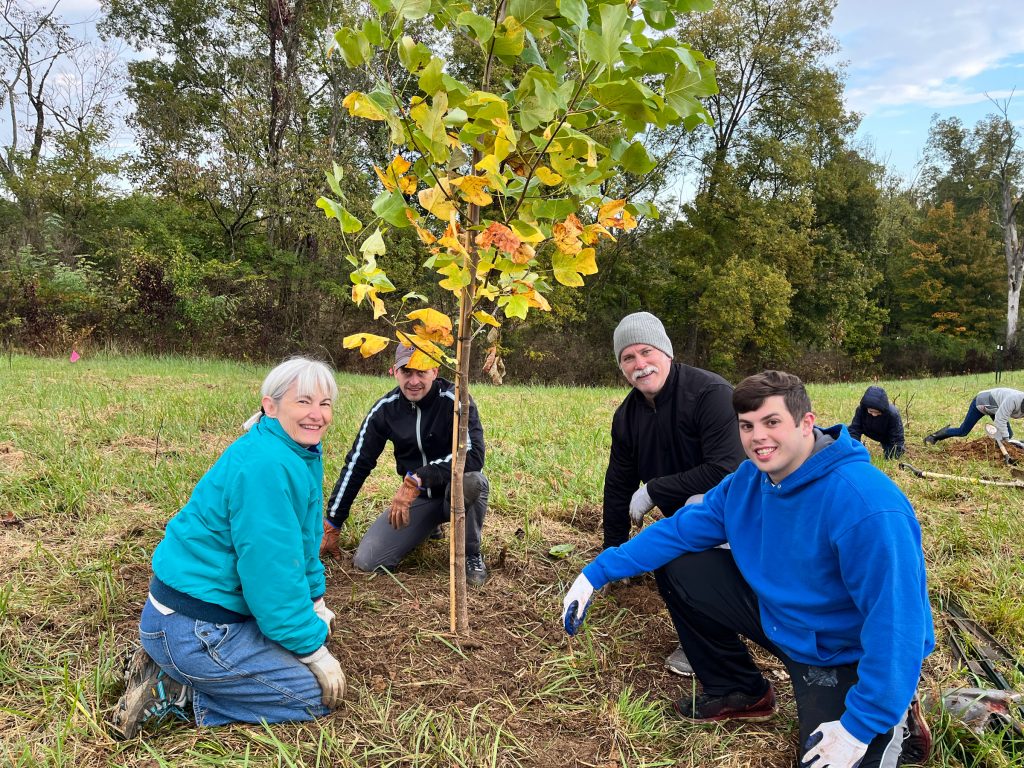
On a chilly, sunny Saturday in October, nearly 100 Great Parks staff and volunteers gathered on an undeveloped edge of Mitchell Memorial Forest to plant 120 trees and shrubs as part of ongoing restoration efforts.
This reforestation planting is part of a larger plan to reduce habitat fragmentation at the site as well as maintain an adjacent meadow to provide habitat for both woodland and open-land species. In Hamilton County and many other places, habitat fragmentation is largely due to roadways and development. Fragmented habitats may not be large enough or connected enough to surrounding natural areas to support the species that use them. Our goal that Saturday was to reconnect a remnant forest to the larger patch nearby.
The Heilmeyer property, located in Mitchell Memorial Forest, was purchased by Great Parks in 2019, using funds from the Clean Ohio grant program. These grants fund the acquisition of land for the purposes of environmental conservation and water quality protection. Clean Ohio funds can also support restoration actions, and Great Parks has been carrying out restoration work on this property over the past three years, including baseline ecological surveys and invasive species removal. Like the other restoration actions, this reforestation planting was funded by Clean Ohio, which paid for trees, shrubs, deer protection and other materials.
All these restoration efforts are aimed at supporting or maintaining the valuable natural resources already present at the site. Habitats present on the property include 35 acres of forest, 15 acres of meadow and a rocky headwater stream. Plant surveys done in the large patch of forest found a number of sensitive and uncommon species. This was not unexpected, as historical aerial photos show this forest existed at least as far back as the 1930s, and older forests typically have more intact plant communities. However, it was more surprising that the surveys also found several interesting species in two small patches of forest next to the road, indicating that these fragments were relatively high-quality forest for their size. The presence of these plants, including sharp-lobed hepatica (Hepatica acutiloba), Dutchman’s breeches (Dicentra cucullaria), and spinulose wood fern (Dryopteris carthusiana), tell us that the ground under this forest was likely never plowed or heavily disturbed.

In addition to the forest, a large gently-sloping meadow is the other most obvious feature of the site. This old hay field is mostly dominated by nonnative cool-season grasses. However, a few native grasses like broom sedge (Andropogon virginicus) and deer-tongue grass (Dichanthelium clandestinum) are present, along with some native wildflowers more tolerant of high-grazing pressure, such as common milkweed (Asclepias syriaca), butterfly milkweed (Asclepias tuberosa) and tall ironweed (Vernonia gigantea).
This field still provides huge benefits for wildlife, especially since Mitchell Memorial Forest and the surrounding area is mostly forested. Species like monarch butterflies (Danaus plexippus), indigo buntings (Passerina cyanea), field sparrows (Spizella pusilla) and eastern bluebirds (Sialia sialis) all use the field, and would no longer be present if the entire meadow became forest.


Above left: A group of volunteers pose with the young tree they planted. Above right: Newly planted trees line the meadow at the Heilmeyer property.
We targeted about four acres of the total meadow present on site during our reforestation initiatives with volunteers on October 23. These acres are relatively small lobes that separate the large forest patch from the small forest fragments near the road. By planting trees in these areas, we are reducing habitat fragmentation and reconnecting the small patches of forest with the larger patch to the southeast, while preserving a large patch of unfragmented meadow. As the forest grows up, this will provide more interior core habitat for woodland wildlife, and eventually, the sensitive and uncommon plants present in the neighboring forest patches will hopefully recolonize the understory of the new forest.
We would be remiss if we didn’t mention that restoration initiatives like this one wouldn’t be possible without the dedication and hard work of our volunteers. This reforestation planting event, part of national Make a Difference Day, was the largest volunteer event Great Parks hosted in 2021. Volunteers within our communities support their parks in multiple ways, and projects like tree plantings show how our community members continue to have an impact on making their parks better for years to come.
—
Daniel Kovar, Conservation Biologist

